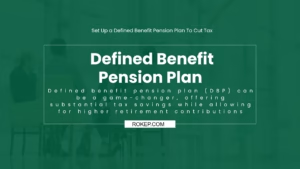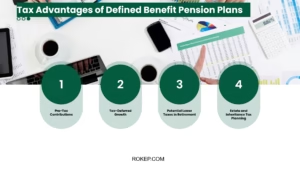For high-income earners, especially those who are self-employed, retirement planning is a major financial priority. However, many retirement savings options, like IRAs and 401(k)s, have relatively low annual contribution limits that may restrict high earners from maximizing their retirement savings and tax benefits. This is where a defined benefit pension plan (DBP) can be a game-changer, offering substantial tax savings while allowing for higher retirement contributions. In this article, we’ll explore how a defined benefit plan works, its potential tax advantages, and why it may be an optimal choice for self-employed professionals looking to make the most of their income.
What is a Defined Benefit Pension Plan?
A defined benefit pension plan, sometimes referred to simply as a “defined benefit plan” or DBP, is a type of qualified retirement plan primarily used by businesses and self-employed individuals to guarantee employees (or the business owner) a fixed income during retirement. Unlike 401(k) or IRA plans, which are defined contribution plans, defined benefit plans focus on what the plan will pay out upon retirement rather than on what’s contributed over time.
In a DBP, annual contributions are determined based on a target retirement benefit and various actuarial assumptions (e.g., age, income, expected retirement age). Contributions often range from $100,000 to over $300,000 per year, depending on factors like income, age, and retirement goals. These amounts are generally much higher than those allowed in defined contribution plans like SEP IRAs or Solo 401(k)s, making defined benefit plans an attractive option for high-income earners.
For more details on defined benefit plans, check out the IRS website.
How Defined Benefit Pension Plans Work
Defined benefit plans are structured to provide a specific payout at retirement, calculated based on salary, age, and years of service. For self-employed professionals, the retirement income will largely depend on your income level and how much you contribute. Contributions are generally calculated with the help of an actuary to ensure the plan meets the retirement goals while staying compliant with IRS guidelines.
Let’s say you’re a 50-year-old consultant with a high annual income. You want to retire at age 65 with a set annual retirement income. Using your age, projected salary growth, and desired retirement age, an actuary can determine how much you need to contribute annually to achieve your goal. These annual contributions are typically tax-deductible, reducing your taxable income significantly in the years leading up to retirement.
Why High-Income, Self-Employed Earners Should Consider a DBP
For self-employed high earners, defined benefit plans offer several advantages that can make a big difference in retirement savings and tax planning:
- Substantial Tax Deductions: Contributions to a defined benefit plan are generally tax-deductible, reducing taxable income significantly. This can be especially valuable for self-employed individuals who might otherwise face substantial tax liabilities. For example, someone with a high annual income can shelter significant income from taxes each year by contributing to a defined benefit plan. Contributions to the plan are deductible up to the IRS limit, which is significantly higher than other retirement plans for high earners. Learn more about contribution limits on the IRS website.
- Higher Contribution Limits: Compared to other retirement accounts, DBPs allow far higher contributions. While the 2023 limit for a Solo 401(k) maxes out at around $66,000 (including catch-up contributions), a DBP may allow contributions of $100,000 or more annually, especially if the participant is over 50. This means more savings can grow tax-deferred in the plan.
- Accelerated Retirement Savings: High-income earners who start saving later in life can use DBPs to “catch up” on retirement savings. Due to the generous contribution limits, individuals nearing retirement can accelerate their retirement savings considerably in a relatively short time.
- Retirement Income Security: With a DBP, there’s less worry about running out of retirement savings, as the plan aims to provide a steady income stream for the retiree’s life. This offers peace of mind, knowing that retirement income is secure and not subject to market fluctuations, as often happens with defined contribution plans.
- Estate Planning Benefits: If properly structured, a DBP can benefit both the retiree and their heirs. In the event of death, some defined benefit plans offer death benefits that can be passed to beneficiaries, although this depends on the specific plan structure.
Steps to Set Up a Defined Benefit Pension Plan
Establishing a defined benefit plan as a self-employed individual or small business owner involves several steps, often requiring the guidance of a financial advisor, actuary, or pension consultant. Here’s a basic outline of the process:
- Consult with a Financial Planner or Actuary: Setting up a DBP requires actuarial calculations to ensure compliance with IRS rules. A financial planner or actuary can help determine how much you need to contribute annually to meet your retirement goals.
- Choose a Plan Administrator: Defined benefit plans involve ongoing administration, including required annual filings with the IRS. A third-party administrator (TPA) can help with these tasks, ensuring compliance with government regulations and overseeing plan administration.
- Define Your Retirement Goals: It’s essential to know what you want to achieve with the plan. Specify the income you’d like to receive upon retirement, considering your lifestyle goals and retirement age.
- Establish the Plan and Begin Funding: Once the plan is set up, begin making regular contributions. As mentioned earlier, these contributions are typically tax-deductible, so it’s beneficial to make the maximum allowable contribution if possible.
- Monitor and Adjust the Plan as Needed: Since defined benefit plans are structured based on actuarial assumptions, it’s essential to review and adjust the plan periodically with an actuary to ensure it remains on track. The IRS requires periodic testing to ensure compliance and that contributions are adequate to meet future obligations.
Tax Advantages of Defined Benefit Pension Plans
One of the most compelling reasons to consider a DBP is the tax advantage. Contributions made to a DBP are typically tax-deductible for the employer (or self-employed individual), reducing overall taxable income. For high-income earners in a high tax bracket, this can amount to tens of thousands of dollars in tax savings each year. Here’s a closer look at some of the tax benefits:
- Pre-Tax Contributions: Contributions to a DBP are generally tax-deductible, meaning you reduce your taxable income significantly each year you contribute.
- Tax-Deferred Growth: Earnings within the DBP grow on a tax-deferred basis, allowing contributions and returns to compound faster than they would in a taxable account.
- Potential Lower Taxes in Retirement: Many high-income earners end up in a lower tax bracket upon retirement, which means funds withdrawn from the DBP during retirement may be taxed at a lower rate.
- Estate and Inheritance Tax Planning: For those looking to pass on wealth to heirs, a DBP can also serve as an estate planning tool, allowing assets to be passed on tax-efficiently in certain cases.
Defined Benefit Pension Plan vs. Defined Contribution Plans
While DBPs have unique advantages, it’s essential to consider their differences from defined contribution plans like 401(k)s and SEP IRAs. Here’s a comparison:
- Contribution Limits: DBPs allow much higher annual contributions, especially as participants near retirement age.
- Income Security: Unlike 401(k) plans, which fluctuate based on market conditions, DBPs promise a set payout.
- Tax Deduction Potential: DBPs generally offer more significant tax savings for high-income earners than SEP IRAs or 401(k)s.
However, DBPs also have some limitations. They’re complex to set up, require actuarial assessments, and come with required annual contributions. Business owners should be confident about maintaining steady income levels, as contributions must continue each year to avoid plan termination.
Drawbacks and Considerations
Though beneficial for tax planning, DBPs do come with considerations:
- Administrative Complexity: DBPs require annual filings with the IRS and Department of Labor, plus periodic actuarial evaluations.
- Required Contributions: Contributions are required annually; inconsistent income may complicate funding.
- Fees: DBPs often come with higher fees than other retirement plans due to the required administration and actuarial assessments.
To make an informed decision, consult with a tax advisor, actuary, or financial planner who can guide you on whether a DBP aligns with your income level, tax situation, and retirement goals.
Conclusion
For high-income, self-employed earners, a defined benefit pension plan offers a powerful tool to maximize retirement savings while cutting down on taxes. By providing higher contribution limits and the possibility for substantial tax deductions, DBPs offer a unique advantage over other retirement plans, particularly for those nearing retirement age and looking to catch up on their savings. Though these plans come with specific administrative requirements and financial commitments, the benefits can far outweigh the costs for many high earners.
With proper planning and the assistance of qualified professionals, self-employed individuals can use a DBP to ensure a secure retirement while sheltering income from taxes during their high-earning years. To get started, consider consulting resources like the IRS and Department of Labor for more information on the setup, administration, and benefits of defined benefit plans.


